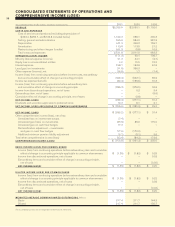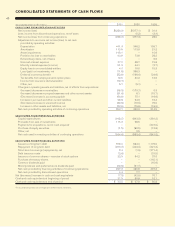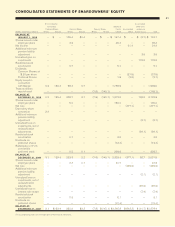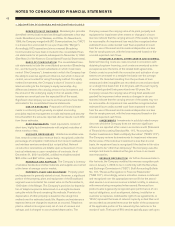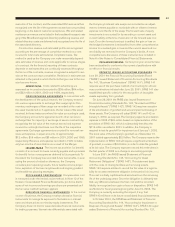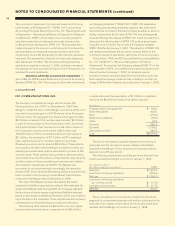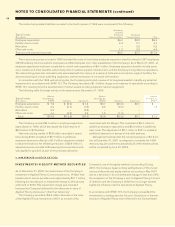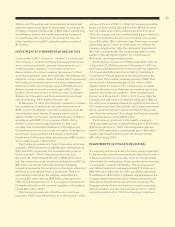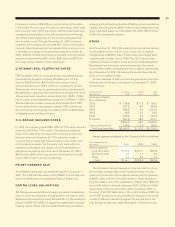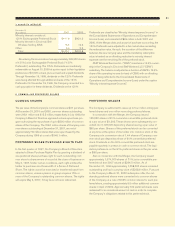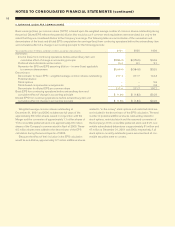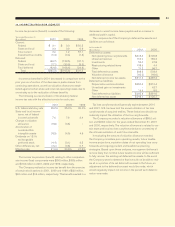Cincinnati Bell 2001 Annual Report Download - page 45
Download and view the complete annual report
Please find page 45 of the 2001 Cincinnati Bell annual report below. You can navigate through the pages in the report by either clicking on the pages listed below, or by using the keyword search tool below to find specific information within the annual report.
43
execution of the contract, and the associated IRU revenue is then
recognized over the life of the agreement as services are provided,
beginning on the date of customer acceptance. IRU and related
maintenance revenue are included in the broadband transport cate-
gory of the Broadband segment. Directory publishing revenue and
related directory costs are deferred and recognized over the life of
the associated directory.
Construction revenue and estimated profits are recognized
according to the percentage of completion method on a cost
incurred to total costs estimated at completion basis. The
method is used as the Company can make reasonably depend-
able estimates of revenue and costs applicable to various stages
of a contract. As the financial reporting of these contracts
depends on estimates that are continually assessed throughout
the terms of the contracts, revenue recognized is subject to revi-
sion as the contract nears completion. Revisions in estimates are
reflected in the period in which the facts that give rise to the revi-
sion become known.
ADVERTIS I NG Costs related to advertising are
expensed as incurred and amounted to $39 million, $64 million,
and $22 million in 2001, 2000 and 1999, respectively.
F I B E R EXCHANGE AGREEMENTS In connection with
the development of the optical network, the Company entered
into various agreements to exchange fiber usage rights. Non-
monetary exchanges of fiber usage are recorded at the cost of
the asset transferred or, if applicable, the fair value of the asset
received. In those instances where fair value accounting is used,
the Company accounts for agreements with other carriers to
exchange fiber for capacity or exchange of service contracts by
recognizing the fair value of the revenue earned and expense
incurred on a straight-line basis over the life of the respective
agreements. Exchange agreements accounted for noncash rev-
enue and expense, in equal amounts, of approximately
$12 million, $19 million and $3 million in 2001, 2000 and 1999,
respectively. Revenue and expense recorded in 1999 includes
only two months of amortization as a result of the Merger.
INCOME TAXE S The income tax provision (or benefit)
consists of an amount for taxes currently payable and a provision
(or benefit) for tax consequences deferred to future periods. To
the extent the Company has recorded future tax benefits, in eval-
uating the amount of valuation allowance, the Company
considers prior operating results, future taxable income projec-
tions, expiration of tax loss carryforwards and ongoing prudent
and feasible tax planning strategies.
STOCK-BASED COMP E N SATION Compensation cost
is measured under the intrinsic value method. In Note 12 of the
Notes to Consolidated Financial Statements, pro forma disclo-
sures of net income and earnings per share are presented as if
the fair value method had been applied.
DERIVATIVE FINANCIAL INSTRUMENTS In the normal
course of business, the Company employs derivative financial
instruments to manage its exposure to fluctuations in interest
rates and share prices on minority equity investments. The
Company does not hold or issue derivative financial instruments
for trading purposes. Interest rate differentials associated with
the Company’s interest rate swaps are recorded as an adjust-
ment to interest payable or receivable with an offset to interest
expense over the life of the swap. The forward sale of equity
investments is accounted for by recording a current asset and
current liability at the time of execution of the forward sale con-
tract. Once the forward contract is settled, the gain or loss on
the hedged investment is reclassified from other comprehensive
income to a realized gain or loss and the current asset and cur-
rent liability are removed from the Company’s books. A more
comprehensive discussion of these instruments is included in
Note 6 of the Notes to Consolidated Financial Statements.
RECLASSIFICATIONSCertain prior year amounts have
been reclassified to conform to the current classifications with
no effect on financial results.
RECENTLY IS S U E D AC C OUNTING STANDARDS On
June 29, 2001 the Financial Accounting Standards Board
(“FASB”) issued Statement of Financial Accounting Standards
No. 141, “Business Combinations” (“SFAS 141”). SFAS 141
requires use of the purchase method of accounting for all busi-
ness combinations initiated after June 29, 2001. SFAS 141 also
established specific criteria for the recognition of intangible
assets separately from goodwill.
On June 29, 2001 the FASB also issued Statement of
Financial Accounting Standards No. 142, “Goodwill and Other
Intangible Assets” (“SFAS 142”). SFAS 142 requires cessation
of the amortization of goodwill and annual impairment testing of
those assets. The Company will adopt SFAS 141 and 142 on
January 1, 2002, as required. The Company expects amortization
expense in 2002 of $45 million based on implementation of the
provisions of SFAS 142, which is substantially less than the
$114 million recorded in 2001. In addition, the Company is
required to test its goodwill for impairment as of January 1, 2002.
The book value of the Company’s goodwill as of December 31,
2001 totaled approximately $2.0 billion. The Company expects the
implementation of SFAS 142 will require a significant write-down
of goodwill, in excess of $1.0 billion, in order to state the goodwill
at its fair value. The Company expects to record this write-down in
the first quarter of 2002 as a change in accounting principle.
In June 2001, the FASB issued Statement of Financial
Accounting Standards No. 143, “Accounting for Asset
Retirement Obligations” (“SFAS 143”). This statement deals
with the costs of closing facilities and removing assets.
SFAS 143 requires entities to record the fair value of a legal lia-
bility for an asset retirement obligation in the period it is incurred.
This cost is initially capitalized and amortized over the remaining
life of the underlying asset. Once the obligation is ultimately set-
tled, any difference between the final cost and the recorded
liability is recognized as a gain or loss on disposition. SFAS 143
is effective for fiscal years beginning after June 15, 2002. The
Company is currently evaluating the impact, if any, that
SFAS 143 will have on its future consolidated financial statements.
In October 2001, the FASB issued Statement of Financial
Accounting Standards No. 144, “Accounting for Impairment or
Disposal of Long-Lived Assets” (“SFAS 144”). SFAS 144 super-
sedes Statement of Financial Accounting Standard No. 121,







